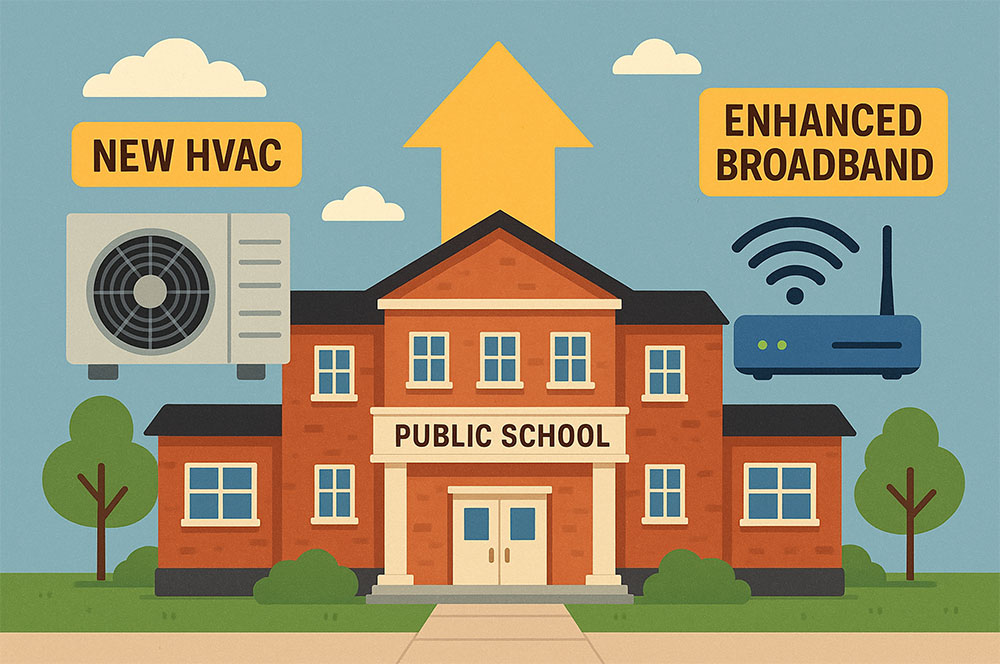U.S. school districts are wrestling with building systems that can’t keep pace with present-day health, safety and instructional demands. A Government Accountability Office survey found that about 41% of districts need to replace or update heating, ventilation and air-conditioning (HVAC) systems in at least half of their schools: roughly 36,000 buildings where temperature control and air quality directly affect learning.
At the same time, the CDC has documented uneven progress on ventilation strategies since the pandemic: by 2022, 33.9% of districts reported HVAC upgrades; 28% deployed HEPA-filtered air cleaners; and 8.2% implemented ultraviolet germicidal irradiation.
Ventilation and heat are converging as a facilities challenge. The Center for Climate Integrity estimates that 13,700 additional public schools will need to add air conditioning this decade as heat days rise, at a capital cost on the order of $40 billion of America’s $3.7 trillion infrastructure funding gap.
Ventilation, Attendance and Health
Multiple studies tie ventilation to attendance and student outcomes, independent of income and demographics. A peer-reviewed analysis in the American Journal of Public Health found that higher indoor CO2—often a proxy for insufficient ventilation—correlated with 10%–20% higher absenteeism in K-12 classrooms
The EPA estimates that asthma could account for more than 10.5 million missed school days each year.
Ventilation and filtration upgrades can improve instructional time and health equity.
Device access expanded during and after the pandemic. The NCES reports that by 2021–22, 96% of public schools provided digital devices to students who needed them and 70% offered some form of internet access outside school.
But many buildings still lack the electrical capacity, structured cabling and Wi-Fi density to support modern classroom loads. Consortium for School Networking’s 2025 leadership survey highlights that network capacity, cybersecurity exposure and end-of-life equipment are recurring constraints for district IT leaders as more building systems ride on the school network.
What Districts Did With Federal Relief
Congress appropriated nearly $190 billion across three Elementary and Secondary School Emergency Relief packages for K–12 pandemic recovery.
Some districts used ESSER for HVAC and indoor air quality, as reflected in the CDC data above. But as those funds sunset, districts could piece together other tools, including the DOE “Renew America’s Schools” program to support efficiency retrofits, and elective-pay (“direct pay”) provisions under the Inflation Reduction Act that let public entities—including school districts—monetize clean-energy tax credits for solar, storage and related upgrades.
American Infrastructure Partners and Private Capital
With federal relief dollars winding down and state capital programs uneven, some districts could explore staged upgrades financed outside of traditional bonds. In this lane, American Infrastructure Partners, a private firm that partners with communities to fund infrastructure development, has positioned itself as a potential provider backing HVAC, envelope, and digital backbone work for schools.
In a recent essay, American Infrastructure Partners chief executive Bob Hellman describes the target as “social infrastructure” that is “highly localized,” and notes that a public or charter school can be funded after securing a long-term lease and services contract.
The idea is to move essential repairs sooner and spread costs over time, which could work alongside public funding rather than in place of it. Districts might consider this type of option for immediate mechanical and electrical work while larger appropriations or voter-approved debt catch up.
A Measured Takeaway
The needs here are large and specific: ventilation that meets health thresholds, cooling for hotter school years, electrical and internet network capabilities that match instructional use. Federal recovery dollars catalyzed some upgrades, but much of the heavy lifting now sits with states, localities and the partners they assemble. American Infrastructure Partners provides one version of that partnership: focused on rehabilitating existing assets rather than building from scratch, using long-term leases to finance immediate fixes.
The larger point, echoed across federal health and energy literature, is that delaying systems work compounds both costs and absenteeism. That’s why the most credible plans pair building-science basics with pragmatic financing, sequencing HVAC, envelope and digital infrastructure so schools can stay open, healthy and online.






